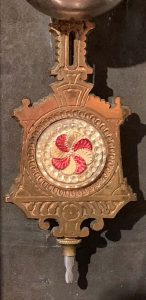Clocks are most useful when they keep accurate time. While very few mechanical clocks are as accurate as modern quartz movements and no mechanical clock will ever match the absolute accuracy of your cell phone or computer’s US Naval Observatory Master Clock-synched time, even fairly low-grade mechanical clocks are more than good enough for regular household use if you take a little time to adjust them.
The rate of a clock is determined mostly by the length of its pendulum. Several other factors affect the timing of a clock to a smaller degree including the power curve of the clock’s mainspring (fully-wound springs are much stronger than nearly wound-down springs) and environmental factors like temperature and humidity.
The Impressive Escapement
I’ve been fascinated by mechanical timekeeping devices my whole life. Though my career is in Information Technology and I spend 40 hours a week on the cutting (and sometimes bleeding) edge of technology, there is something I find impressive about a relatively simple, hundreds of years old mechanical device.
Most clocks run 8 days on a wind and were intended to be wound weekly. A ubiquitous “kitchen clock” has a beat rate around 9300 beats per hour, which multiplied by 168 hours in a week, means the clock ticks 1,562,400 times per week. With a pendulum swing of around an inch, that means the pendulum runs a marathon – 26 miles – each week!
Mechanical clocks are also incredibly energy-efficient. Our example kitchen clock’s mainspring drives a gear ratio of nearly 3000:1 with a force of only a couple foot-pounds of energy.
Reasonable Expectations
Because of the sheer number of ticks a clock must make over the course of a week and the sensitivity of the mechanism, some errors are inevitable. A clock that gains or loses one minute per week – something that should be attainable by pretty much any antique clock if it’s in good condition – is 99.99% accurate. Weight-driven clocks often do even better than this as their driving force is constant, while spring-driven clocks tend to run a bit fast at the beginning of the week when the spring is strongest and then slow down slightly later in the week.
I true up my clocks when I wind them. The clock on your cell phone is a great tool for this, as its clock is always perfectly correct since it is synchronized with international time standards. You can carry around this perfectly accurate time reference as you wind your clocks and easily make slight time adjustments. Your phone clock will also reveal any clocks that are significantly out of whack.
Setting The Time
Most clocks are adjusted by carefully moving the minute hand. There are a few things to watch out for.
Advancing The Clock
Time-only clocks can usually be adjusted either forward or backward, and as long as you are gentle, you are unlikely to cause any harm. Clocks that chime or strike require more care. If you need to set the clock ahead, you may do that slowly as long as you stop to allow the striking or chiming sequence to fully complete before you move the hand.
Setting The Clock Back
Once again, time-only clocks can be adjusted forward or backward. Setting a chiming or striking clock backward requires extra care, as the chiming or striking mechanisms interact with the time train and can be damaged if adjusted incorrectly.
The safest way to set a chiming or striking clock backward is to stop the pendulum and wait until time catches up with the clock’s setting.
With care, you can in some circumstances set a chiming or striking clock back. As a general rule, you can set a clock a few minutes backwards if it’s in the first quarter hour – between 12:00 and 3:00, or the third quarter hour – between 6:00 and 9:00. These are the periods where the chiming or striking sequence has finished and some motion is possible. Do not try to move the minute hand backward across the 12, 3, 6, or 9 as you will likely damage something. If you feel resistance, then stop moving the hands! Stop the pendulum and restart it when time catches up with what the clock displays.
Adjusting The Rate Of The Clock
 If my clocks are running within 2 minutes per week of the correct time, I will normally just move the hands to the correct time and not try to do further regulation, as often times due to changes in temperature or humidity, the clock will run at a slightly different rate the next week, and I may end up chasing my tail. If a clock is consistently running fast or slow, then I will try to adjust the rate of the clock.
If my clocks are running within 2 minutes per week of the correct time, I will normally just move the hands to the correct time and not try to do further regulation, as often times due to changes in temperature or humidity, the clock will run at a slightly different rate the next week, and I may end up chasing my tail. If a clock is consistently running fast or slow, then I will try to adjust the rate of the clock.
 The rate of a clock is usually adjusted in one of several ways – either by a nut mounted near the bottom of the pendulum, a small square shaft through the dial adjusted with a small key, or a lever on the rear of the clock. Adjustments that make the pendulum shorter cause the clock to run faster, and adjustments that make the pendulum longer cause the clock to run slower.
The rate of a clock is usually adjusted in one of several ways – either by a nut mounted near the bottom of the pendulum, a small square shaft through the dial adjusted with a small key, or a lever on the rear of the clock. Adjustments that make the pendulum shorter cause the clock to run faster, and adjustments that make the pendulum longer cause the clock to run slower.
Small changes in pendulum length can make big changes in timekeeping. For clocks with adjustable pendulum bobs, a quarter-turn is a good starting point for an error of a couple minutes per week. Through-dial adjustment shafts are similar – start with 1/4 turn or so. For clocks with a lever adjustment, make a small change of only a few degrees at a time.
I find that I adjust the rate of my clocks mostly in the spring and in the fall, when seasonal temperature and humidity adjustments are greatest.
Winding Schedule
Mechanical clocks require maintenance – at a minimum they need to be regularly wound. Some clocks need to be wound every day. It requires dedication to use a 30-hour clock regularly, but if you’re willing to put the time in to wind every day, go for it. Most clocks run for 8 days on a wind (assuming they are in reasonable operating condition – a clock that runs less than a week needs to be serviced), and they were intended to be wound weekly. Choose a day and time when you will normally be home to wind your clocks, and add it to the routine. I wind my clocks Sunday evenings while I wait for my children to get ready for bed. This works for me logistically as well as mentally – winding my clocks becomes part of my routine to get ready for the week.
I have a couple clocks that will run longer than a week, but I still wind them weekly so I don’t forget. I find it’s harder to manage a 30-day wind schedule than a 7-day schedule.
Service and Repair
Antique clocks are mechanical devices and, like your car, need periodic maintenance. With modern high-tech oils, clocks should be able to run for 5-10 years after being serviced. If you purchased a clock with an unknown service history or if it’s been more than 10 years since you’ve had your clock serviced, it’s time to schedule an appointment with your favorite clock repair person. Clocks that are overdue for service will likely be poor timekeepers and are at risk of damage as they are wearing at an accelerated rate.
A full service will include taking the movement completely apart, thoroughly cleaning it, addressing worn or broken items, and then reassembling and testing. This is a time-consuming process, and therefore the cost can be significant depending on what’s needed. With more common clocks that are purchased inexpensively, the service cost can equal or even exceed what you paid for the clock. This seems to be a common conundrum at the moment as clock prices are severely depressed right now. It’s up to you to decide if the cost is worthwhile, but I would suggest that you not look at this through the eyes of an accountant; rather look at this as an opportunity to restore a beautiful object that you purchased at a significant discount.
Once you have a clock fully serviced including taking care of all of the worn or broken items from decades of neglect, which is the normal state for antique clocks, future maintenance will be less expensive as all that will be required is cleaning and oiling.
Is It Worth It?
Many people don’t think the effort and cost of maintaining an antique clock is worth the work, but if you’ve read this far, that’s probably not you. With a bit of care and a few dollars a year saved for an overhaul every decade, antique clocks can bring interest to your home and satisfaction of maintaining a piece of history.
